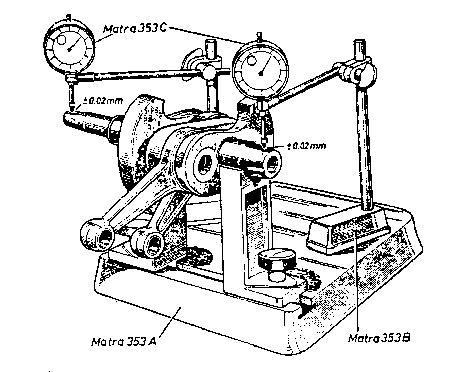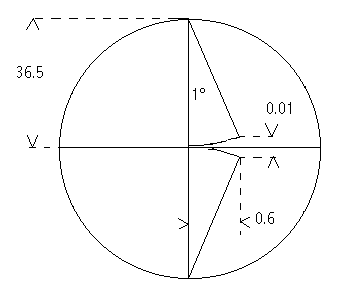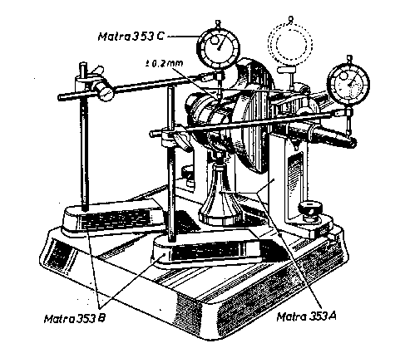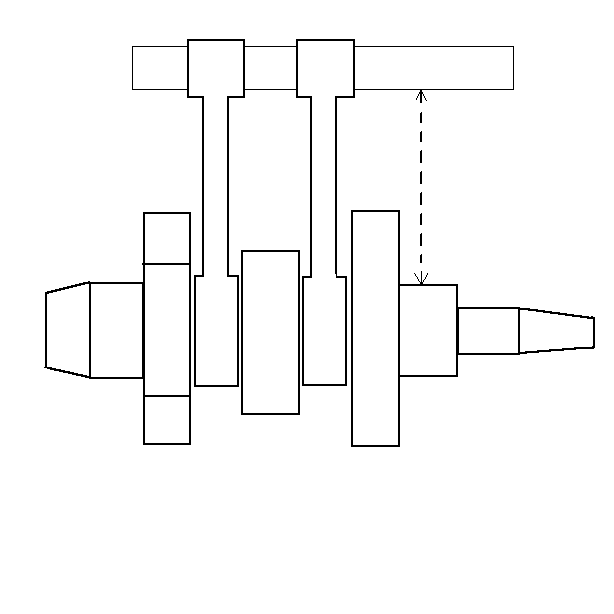
This article is written after a lengthy discussion with Ed Korn about BMW /2 crankshafts, balancing and straightening. In this discussion some ideas popped up, that are not universaly known among the vintage BMW fraternity. So I decided to write them down on this webpage, so everybody can benefit from the result. I appreciate how Ed helped me out with these issues.
The /2 has a very good crankshaft, that was a good piece of engineering in its heighday. But they are old now, and when compared to modern technology they are a bit dated and need some extra attention.
The crankshaft is built up from 5 pieces. The middle web has two holes at 180 degrees, the two crank pins, and the front and aft web. These latter are each forged from one piece and incorporate the shaft for the bearings. The crankpins are hollow, with an oil feed hole for the connecting rod bearings. The oil is pumped to the main bearings, overflows, and is flung into the "slinger plates". These slingers are just round tins with a pressed over rim. Near the rim is a small hole that connects to the hollow crankpin. So the oil is flung into the rim, due to centrifugal action the sludge is spun into the rim and the clean oil can flow into the crankpin. That is, until the rim fill withsludge. The oilhole gets blocked, the crankpin is starved of oil, and the big end bearing is on its way to heaven, taking with him the crankpin and the connecting rod.
Luckily you can get new connecting rods, bearing rollers and crankpins for a reasonable price. The problem though is that the crankshaft is pressed together. To disassemble and reassemble, you not only need at least a 20 ton press, but also a lot of experience and skill. So you send your crank to a reputable shop.
Then there is another problem. The main bearings (6207 or 20207) have an interference fit on the crank journals. That is, the diameter of the journal should be 0.015 - 0.025mm more than the inside diameter of the bearing. When the bearing is too loose on the journal, you have a problem. If you ignore it, the problem will get worse very rapidly because the bearing starts to walk on the journal. Because new crankshafts are rare, and good secondhand ones too, you might want to consider a repair method to build up the worn journals. Usually hard chrome is being recomended, followed by precision grinding. The latter isn't very easy either, because you need special adapters to get the journals centered and parallel. Here in Holland, Stolk in Rotterdam does this service, in the USA, you can ask Ed Korn.
Of course there can be other problems. Like a worn out surface for the front crankshaft seal, rotten threads, cracks around the woodruff keys. Check it all out carefully.
After you get your crank back from the shop, you might want to check it. Whatever the great reputation of the shop, it's always wise to check their work. If they are really great, your check will show everything within tolerances and you will feel very happy. But anybody can make a misstake, even a great shop, and they will happily correct their error. But if it was a poor shop, you are in deep shit, and might want to look for another one, loosing lots of money in the process. It's always best to check the work at each stage. Not like me, sending a frame away for straightening, then rebuilding the bike, only to find that the bike is still pulling heafty to the right two years later.
So meassure the results. You meassure the journals with a micrometer. If you don't have them, borrow, steal or buy one. These days they are not so expensive anymore. You can get a very good Mitutoyo 25-50mm for around $90,-. Work very clean. First zero adjust the micrometer and then use the ratchet to make a meassurement. Make sure you know how to read the result. It's not rocket science, but to be able to meassure within a 0.01 mm you must take care. To be sure you also must measure the innerdiameter of your bearing. Manufactures are allowed to vary the bearing bore betwee 35.001 and 34.988 mm. Lately I have bought an inner-micrometer from a Chinese manufacturer that was quite cheap. You can also get measured bearings from Ed Korn, so you get the best fitting bearing for your crank. This is defenitely something to discuss with your engineshop.
Check if the crank is true. You find this in every BMW workshop manual. You put the crank with its main bearing journals on V-blocks, and put a dial gauge on the very end of the dynamo and the flywheel taper. It shouldn't be more than 0.02mm out of round. A dial gauge and a stand also belong to the standard equipement of home restorer. Also these are very cheap today. You can buy V-blocks, but you can also make your own. Cut both V's together, and file the corners nice and smooth. If you use angle iron, you can mount them with long screws on a base plate, using blocks to get the right height.

Strange that the BMW /2 workshop manual doesn't recommend a check on "180 degreeness" of the crank.
Maybe in those days you only bought cranks from the factory, and these were assumed to be good. But a little bit of reasonable thinking and high school geometrics will show that you can turn a BMW boxer crank in a 178 degree crank, before it shows up into the 0.02mm measurement of the above mentioned check. This causes not only a bad ignition balance, but also a bad weight balance. The distance between the two bearing journals is about the same as the length of the dynamo taper. So what you measure with the dial gauge on the end of the dynamo taper is twice the amount the bearing journals are out of line. When you hit one crankweb with a hammer, it will turn around its corresponding crankpin. If you hit it so hard that the dynamotaper is 0.01mm out of line, you will register a 0.02 mm out of roundness on the dial gauge when you put it back on the V-blocks. The same goes for the other crankweb, or if you wedge the crankwebs apart or press them together. This is all nice and simple for a single cylinder, but not for a boxertwin. Here you can hit both webs in the same direction, while holding the middleweb steady in a vice or so. Looking the crankcshaft in the face, you will get a picture like this:

The flywheel and the dynamo taper will stay reasonably in line for a very long time, so you can pull them 0.6mm from the centreline before you register 0.02mm on the dialgauge. In that case you have a 178 degree crank, and a very real wheight imbalance, because the middle web runs 0.6mm out of line. The average engine shop is not aware of this weird feature.
So how do check for this? The R51/3 workshop manual has a nice picture how you could do it:

You set this up until the dial gauge measures the same on both connecting rod bigends. Then without changing the setting of the jack support or the dial gauge, you turn the crank over and do the same measurement. They should be equal. But the outside of the connecting rods is very rough, and all this moving around of dial gauges doesn't help. But you are looking at a tenth of milimeters measurement, not hundreds. So maybe you get good enough results.
There is a much simpler method though (credit to Ed Korn!). You only need a reasonably straight 20 mm round bar(maybe the piston pin is just long enough), that fits inside the small end bushes (all errors together within 0.05mm) and a dial caliper. Move both small ends to the same side and push the bar through both small end bushes. Measure the distance between the bar and the bearing journal. Rotate the rods to the other side and repeat. Both measurements should be equal.

How precise should it be? The /3 manual sais: Admissable crankshaft out of line is within 0.2 mm. Then each crankweb is 0.3 degree out of line, thus the difference between both top dead centres is 0.6 degree. The weight imbalance is now back to a few gram. In this examples I used the 600 cc engine dimensions, but the difference with the shorter stroke of the R50 is very small.
Good luck with your crank, and explaining to the engine shop, what the hell you are talking about ;-)
Kees van der Heiden, [email protected]
Ed Korn: BMW Motorcycle CATALOG available at: http://www.aetherserv.com/cycleworks/
email: [email protected]
Cycle Works 170 Jackson St. Madison WI 53704 USA Phone: (608)
246-0404